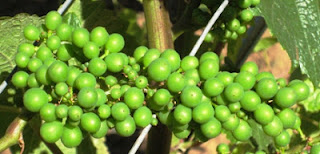Monday, July 23, 2012
Between Fruit Set and Lag
We finished bloom around July 11, in the midst of a 10-day stretch of sunny, dry, mid- to upper-80s weather. Had the previous cool, cloudy weather continued, who knows how much longer bloom would have lasted and potential yield would have declined.
After the terrible bloom conditions, we were fortunate enough to have a good set from the flowers that did pollinate. At this point it's too early to tell how big the berries will be this year, but having started out with fewer than normal numbers and only moderately-sized flower clusters, after the poor pollination we certainly won't be bringing in the amount of grapes we did last year.
The vines themselves are another matter entirely. Since the heat hit shortly after the 4th, they have been growing faster than we can remove laterals, leaves, and shoot tips. "Normally" (if there is such a thing anymore) the soil would have dried sufficiently to have slowed shoot growth by now. But the wet, cool, cloudy weather through June, and the cooler than normal July temps - even though warmer, sunnier, and drier than June - has left plenty of soil moisture to fuel shoot growth. This has probably saved the jobs of a lot of vineyard managers this year, whose vines in June looked like they might not have canopies strong enough to ripen fruit. But for those of us, that were on-track, it's been non-stop work and $s managing the canopy. We've already hedged our vines twice, with at least one more hedging to be done. Having had less than 0.1" of rain so far this month, I'm hoping the shoots slow down before a fourth hedging becomes necessary , but as you can see in the picture above, the grass is still green. Here's what rows from each block are looking like:
Getting back to the fruit, though...Variability is the operative word this year. We have vines with no fruit; vines with 2 clusters on each shoot; normally shaped clusters with uniformly-sized berries; small clusters with wings as large or larger than the primary cluster; loose clusters; odd-shaped clusters; loose, odd-shaped clusters with hens and chicks; you name it. Hopefully, some of this variability will help us minimize Botrytis at harvest time, and perhaps positively impact the complexity of flavors and aromas in the wines of this vintage. Here's what the fruit is looking like:
It remains to be seen what effect the relatively long, slow, and uneven pollinating period this year will have on ripening. Mathematically, mid-bloom occurred sometime around June 28 this year, in our vineyard; pushing the expected beginning of harvest into mid-October.
The weather is forecasted to be sunny, dry, and cooler than normal for the rest of July, which is typically one of the two hottest months of our summer. Hopefully we don't make up for it with a scorcher of an August.
















